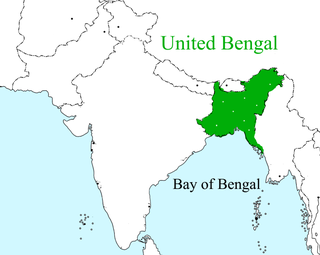
India is a federal republic comprising 28 states and 8 union territories. The states and union territories are further subdivided into districts and smaller administrative divisions.

The Bengal Presidency, officially the Presidency of Fort William in Bengal and later Bengal Province, was a province of British India and the largest of all the three Presidencies. At the height of its territorial jurisdiction, it covered large parts of what is now South Asia and Southeast Asia. Bengal proper covered the ethno-linguistic region of Bengal. Calcutta, the city which grew around Fort William, was the capital of the Bengal Presidency. For many years, the Governor of Bengal was concurrently the Governor-General of India and Calcutta was the capital of India until 1911.

The provinces of India, earlier presidencies of British India and still earlier, presidency towns, were the administrative divisions of British governance on the Indian subcontinent. Collectively, they have been called British India. In one form or another, they existed between 1612 and 1947, conventionally divided into three historical periods:
A Government House is any residence used by governors-general, governors and lieutenant-governors in the Commonwealth and the British Empire. Government Houses serve as the venue for governors' official business, as well as the many receptions and functions hosted by the occupant. Sometimes, the term Government House is used as a metonym for the governor or his office.

Chota Nagpur Division, also known as the South-West Frontier, was an administrative division of British India. It included most of the present-day state of Jharkhand as well as adjacent portions of West Bengal, Orissa, and Chhattisgarh.

Bihar and Orissa was a province of British India, which included the present-day Indian states of Bihar, Jharkhand, and parts of Odisha. The territories were conquered by the British in the 18th and 19th centuries, and were governed by the then Indian Civil Service of the Bengal Presidency, the largest administrative subdivision in British India.

The Bangabhaban is the official residence and principal workplace of the president of Bangladesh, located on Bangabhaban Road, and short road connecting Dilkusha Avenue, Dhaka. It is surrounded by the Bangabhaban Gardens.

Eastern Bengal and Assam was a province of India between 1905 and 1912. Headquartered in the city of Dacca, it covered territories in what are now Bangladesh, Northeast India and Northern West Bengal.

Colonial Assam (1826–1947) refers to the period in the history of Assam between the signing of the Treaty of Yandabo and the Independence of India when Assam was under British colonial rule. The political institutions and social relations that were established or severed during this period continue to have a direct effect on contemporary events. The legislature and political alignments that evolved by the end of the British rule continued in the post Independence period. The immigration of farmers from East Bengal and tea plantation workers from Central India continue to affect contemporary politics, most notably that which led to the Assam Movement and its aftermath.

Greater Bangladesh, or Greater Bengal is the irredentist ideology of Bangladesh to inevitably expand her territory to include the Indian states that currently has, or historically had, large populations of ethnic Bengali people. These include West Bengal, Bihar, Odisha, and Jharkhand to the west, Sikkim to the north, and the states of Arunachal Pradesh, Assam, Meghalaya, Tripura, Mizoram, Manipur, and Nagaland to the east. Greater Bangladesh would naturally therefore take on the more inclusive title of Greater Bengal, as her people would be united under a common ethnicity and heritage based on language rather than one based on religion.
Sir Edward Albert Gait (1863–1950) was an administrator in the Indian Civil Service who rose to serve as Lieutenant-Governor of the Bihar and Orissa Province in the Bengal Presidency of British India. He held that office for the years 1915–1920, with a brief absence during April–July 1918 when Edward Vere Levinge officially acted in the position.

The Government of India Act 1912 was an act of the Parliament of the United Kingdom, which made changes to the governance of British India. It received royal assent on 25 June 1912.
The 1912 Birthday Honours were appointments in the British Empire of King George V to various orders and honours to reward and highlight good works by citizens. The appointments were made to celebrate the official birthday of The King, and were published on 11 June 1912.

Assam Province was a province of British India, created in 1912 by the partition of the Eastern Bengal and Assam Province. Its capital was in Shillong.
The 1911 Delhi Durbar was held in December 1911 following the coronation in London in June of that year of King George V and Queen Mary. The King and Queen travelled to Delhi for the Durbar. For the occasion, the statutory limits of the membership of the Order of the Star of India and the Order of the Indian Empire were increased and many appointments were made to these and other orders. These honours were published in a supplement to the London Gazette dated 8 December 1911.

The Bengal Provincial Muslim League (BPML) was the branch of the All India Muslim League in the British Indian province of Bengal. It was established in Dhaka on 2 March 1912. Its official language was Bengali. The party played an important role in the Bengal Legislative Council and in the Bengal Legislative Assembly, where two of the Prime Ministers of Bengal were from the party. It was vital to the creation of the Dominion of Pakistan, particularly after its election victory in 1946.
Sir Archdale Earle, KCIE was a British Indian administrator and former Chief Commissioner of Assam Province.








